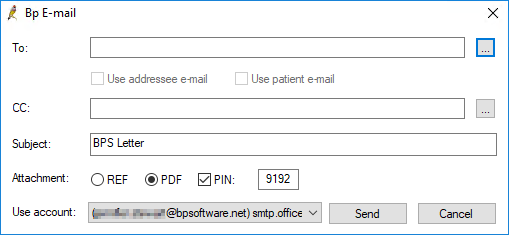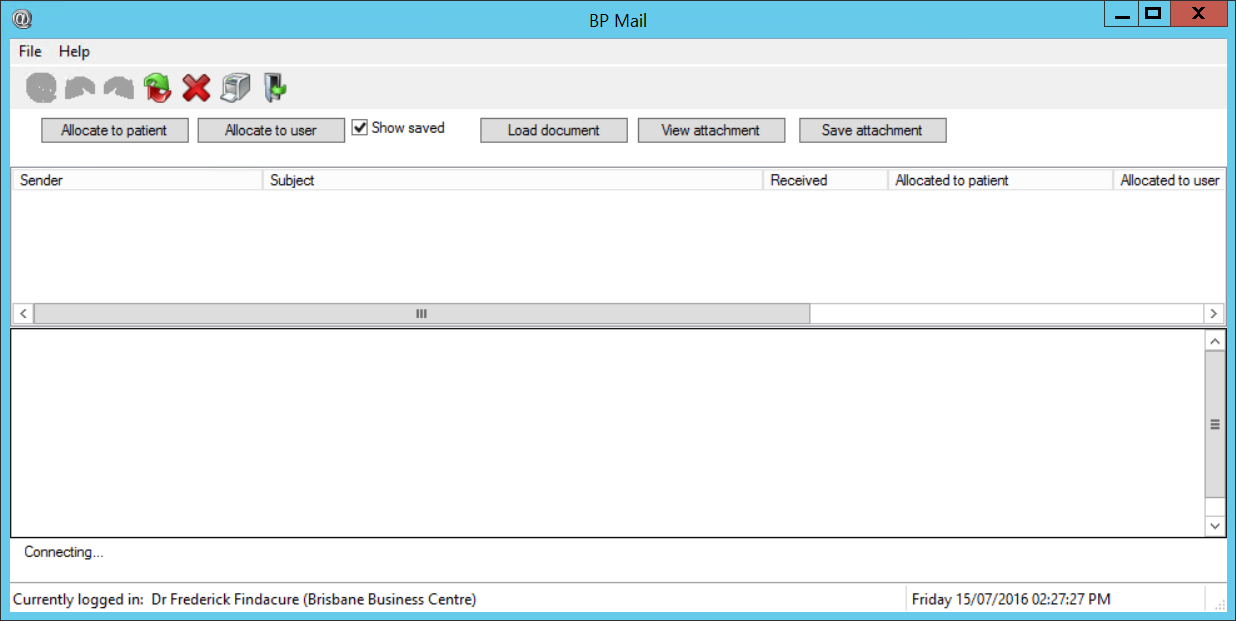Saffron SP2 introduces improved email functionality to Bp Premier, including the ability to send pin-protected PDF files from the word processor.
You must have email configured for the practice and for any users who want to send email messages.
Send emails from the word processor
You can only send emails from the word processor, you cannot view incoming emails. If a user's account or the practice has been configured for email via Setup > Configuration > Email, the e-mail icon ![]() will be enabled on the word processor toolbar.
will be enabled on the word processor toolbar.
Sending email from the word processor allows you to send word processor documents as attachments.
NOTE When sending emails from the word processor, the email body text is generic. You cannot set the text on outgoing emails.
- Open the word processor and create the letter to be emailed, from template or a blank document.
- Click
 on the toolbar, or select File > Send Mail to display the BP E-mail screen.
on the toolbar, or select File > Send Mail to display the BP E-mail screen. - Choose an address for the To: field:
- If the template prompted you to select a contact, the contact's email address will be displayed automatically in this field.
- If you are in a patient record, or the template prompted for a patient's name, tick Use patient e-mail to insert the patient's email address.
- If the template asked you for an addressee, tick Use addressee email to insert the addressee's email address.
- Click ... to display the E-mail address screen and search for a contact's or patient's email address. Only contacts or patients with an email address recorded in Bp Premier will appear in the search.
- Type in the email address to send to.
- Click ... next to the Copies to field to insert contact or patient email addresses to send an electronic copy to. Only contacts or patients with an email address recorded in Bp Premier will appear in the search.
- Enter a Subject for the email. The subject will default to the template name if a template has been used, and the patient name if the word processor was opened from the patient record.
- Select Attach REF file if available, or REF in Saffron SP2, to attach a patient reference file, if applicable.
- Select PDF to send a PDF attachment of the word processor document in the email. If you select PDF, the PIN checkbox will appear.
- If you have selected PDF and you wish to secure the PDF with a PIN number, select PIN.
- The Use account menu indicates the outgoing, or 'from' email address. If you have a user email address set up in Bp Premier, it will appear in this menu. If you do not have a user email address set up in Bp Premier, the practice email address will appear.
- Click Send to send the letter by email.

If you have opened the word processor from a patient record, the PIN will default to the patient's day and month of birth, for example, 2912 for 29 December. If you have not opened the word processor from the patient record, the PIN will be random. Take note of the PIN to provide to the patient, as this number is not stored in Bp Premier.
Even if you are sending an email from a practice account, the logged in user's name will appear as the sender when the patient receives the email.
If the email was sent from a patient record, an action will be created in Today's notes indicating that the email was sent. However, a contact note will not be created for the email.
NOTE The size limit for documents sent via email is 3MB. An error message will appear if you attempt to send a document larger than 3MB.
Manage incoming email
NOTE Incoming email is deprecated in Saffron SP2. Best Practice Software does not recommend using this feature.
The BP Mail screen manages incoming emails. From this screen you can allocate emails to patients or providers, and save attachments.

There are two paths to the BP Mail screen:
- If your practice uses a practice email address for all incoming emails, select View > Practice email. The user will require the Practice email user permission set to 'Allowed'.
- If your practice allows users to receive emails to their individual email address, select View > Incoming email. Only emails sent to the user's email address will be displayed.
- From the main screen of Bp Premier, open the BP Mail screen. By default, the BP Mail screen shows all received emails that have not been allocated.
- Use the options at the top of the screen to manage the received emails.
Button | Action | |
|---|---|---|
Create New Email |
| Create a new email message |
Reply to Sender |
| Reply to the sender of the selected email |
Send / Receive |
| Check for new emails |
Delete email |
| Delete the selected email |
Print email |
| Print the selected email |
Allocate to patient | Allocates the email to the patient within the View > Incoming Email (BP Email) window. This action will not yet save the email to the patient’s record. After the email has been assigned to the patient, the user can right-click on the email and either Move to Correspondence in or Move to Inbox to move to the patient record or provider inbox. | |
Allocate to user | Allocates the email to a user within the View > Incoming Email (BP Email) window. This action will not yet save the email to a provider inbox. After the email has been allocated, the user can right-click on the email and Move to Inbox to move to the patient record or provider inbox. You can also change who the email is assigned to. | |
Show saved | Tick to show all emails received, including emails saved to a patient record. | |
Load document | If the attachment is a Microsoft Word document, click to display the contents of the attachment in the bottom of the screen. | |
View attachment | Opens the attachment for viewing. | |
Save attachment | Saves the attachment to file, so the file can be imported into a patient record separately. | |
To save an email, highlight the email and select File > Save. The email will be saved into the BP Mail window. For example, an email may not be assigned to a patient or a user, but the user wants the email removed from the incoming list. Users can retrieve the saved incoming email by ticking Show saved.
Last updated 25 October 2021